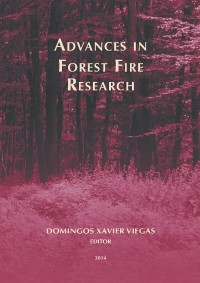Please use this identifier to cite or link to this item:
https://hdl.handle.net/10316.2/34108| Title: | Numerical investigations of 3D aspects of fire/atmosphere interactions | Authors: | Linn, R. R. Canfield, J. M. Sauer, J. Finney, M. Frothofer, J. Winterkamp, J. L. Sieg, C. H. Pimont, F. Dupuy, JL |
Keywords: | coupled fire/atmosphere;FIRETEC;grassfire;wildfire behaviour;vorticity;vortex | Issue Date: | 2014 | Publisher: | Imprensa da Universidade de Coimbra | Journal: | http://hdl.handle.net/10316.2/34013 | Abstract: | Idealized FIRETEC grassfire simulations were used to study some of the roles that three-dimensional aspects of coupled atmosphere/fire interactions play on fire behavior. Domains of various widths that were periodic in the cross-stream direction, simulating an infinite-length fireline, were used to isolate local fireline-scale three-dimensional effects. Two-dimensional vertical plane (zero width) simulations were performed for comparison. Idealized finite-length fire simulations were used to study the larger fire-scale three-dimensional effects. In the infinitely long simulations the fireline remains fairly straight on a macroscale while significant heterogeneities develop along the fireline at fireline-scales. These simulations suggest that the nature of atmosphere–fire coupling and these heterogeneities are influenced by wind speed. At low wind speed, the spread rate is not significantly affected by the width of the domain (for domains greater than 10 m wide). For higher wind speeds, the flank of the simulated firelines is fingered and the front of the fireline exhibits lobes. The average spread rates vary by approximately 20% for the different domain widths. In the finite-length fireline simulations, the fireline shape was fairly parabolic and the headfire rate of spread (ROS) increased with wind speed and length of ignition line. The curvature of the fire was also influenced by the length of the ignition line. The indrafts of the headfire and flanking fire lines compete for upstream wind. For wider fires, the separation between the flanking fire lines is larger and more of the upstream wind is able to reach the headfire. These finite-length simulations also suggest that there might be an overall negative pressure gradient from upwind of the fireline to downwind of the fireline near the ground. This pressure gradient is believed to be tied to the penetration of wind through the fireline and the convective heating of unburned fuel. Streamwise-vorticity pairs contribute to the heterogeneous appearance of the fire front by feeding upward momentum in the location where towers are seen on the fireline and thrusting hot gases through the fireline and down to the unburned fuel in the troughs between the firelines. These streamwise vorticies have also been recognized in the periodic infinite length and finite-length simulated firelines as well as laboratory tests. In the two-dimensional simulations with wind speeds above 3 m/s, one major effect of the two-dimensional restrictions is to preclude the nominally streamwise-vorticity structures from forming upstream of the fireline. This thus diminishes the ability of the wind to mix through the heated plume and entrain hot gases down into the fuels ahead of the fire. These simulations suggest that caution should be used when attempting to use one or two-dimensional models to simulate wildland fires. These simulations also suggest the significant value of experiments in which details of both flow and fire dynamics can be studied at scales ranging from fireline scale to overall fire geometry scales in order to better understand fire behavior. The hypothesis generated here can help provide insight in support of experimental design and analysis. | URI: | https://hdl.handle.net/10316.2/34108 | ISBN: | 978-989-26-0884-6 (PDF) | DOI: | 10.14195/978-989-26-0884-6_41 | Rights: | open access |
| Appears in Collections: | Advances in forest fire research |
Files in This Item:
| File | Description | Size | Format | |
|---|---|---|---|---|
| 978-989-26-0884-6_41.pdf | 1.68 MB | Adobe PDF |  |
Items in DSpace are protected by copyright, with all rights reserved, unless otherwise indicated.
